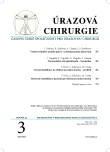-
Medical journals
- Career
POSSIBILITIES OF REHABILITATION OF PATIENTS AFTER SEVERE BRAIN INJURY
Authors: Tomáš Brož 1; Albert Kharisov 1; Martin Carda 2
Authors‘ workplace: Department of Neurosurgery, Regional Hospital Pardubice, a. s. 1; Neurochirurgické oddělení, Pardubická Krajská Nemocnice, a. s. 1; Department of Trauma Surgery, Department of Surgery, Regional Hospital Pardubice, a. s. 2; Oddělení Úrazové chirurgie, Chirurgická klinika, Pardubická krajská nemocnice, a. s. 2
Published in: Úraz chir. 22., 2014, č.3
Overview
OBJECTIVE:
Despite improvement in therapeutic options for patients with severe brain injury, the treatment of these patients is still highly problematic for doctors and therapists. Today, it is clear that the majority of these patients, without the possibility of rehabilitation will never reach required forms of cooperation. It is to the credit of early modern rehabilitation that it could demonstrate its high efficiency only when it was started during the acute phase. The aim of this report is to present results of a prospective study of rehabilitation treatment in patients after severe brain injury.MATERIAL AND METHODS:
The prospective study included 71 patients with severe brain injury with the initial GCS 8 points or less, and who have received early rehabilitation including multisensory - orientated rehabilitation. Patients were hospitalized in Pardubice Regional Hospital, a. s. between the years 2006 - 2013.RESULTS:
The purpose of this work was to evaluate the functional outcome of rehabilitation treatment with regard to post-traumatic deficits, both physical and mental, including neuropsychological testing using a battery of tests, as well as assessment by GOS Glasgow Outcome Scale (range allows assessment of the status and degree of impairment of consciousness) and DRS.CONCLUSION:
The complex care of patients with severe brain injury is necessary, because a significant number of patients have a chance to achieve a satisfactory outcome of therapy and full life. Our aim was to hold on to the basic principles of rehabilitation of patients with TBI and bring them into clinical practice in their widest form. The results presented in this summary show the high degree of success of early neuro - rehabilitation.Key words:
Severe brain injury, early rehabilitation, pacing therapy, persisting deficits.
Sources
1. ANDREWS, K. Patients in the persistent vegetative state: problem in their long term management. British Medical Journal. 1993, 306, 1600–1603.
2. ARUNDINE, A., BRABDURY, CL., DUPUIS, K. et al. Cognitive behavior therapy after acquired brain injury: maintenance of therapeutic benefits at 6 months posttreatment. J Head Trauma Rehabil. 2012, 27, 104–112.
3. BANOS, JH., NOVACK, TA., BRUNNER, R. et al. Impact of Early Administration of Sertraline on Cognitive and Behavioral Recovery in the First Year After Moderate to Severe Traumatic Brain Injury. J Head Trauma Rehabil. 2010, 25, 357–536.
4. CICERONE, KD., LANGENBAHN, DM., BRADEN, C. et al. Evidence-based cognitive rehabilitation: updated review of the literature from 2003 through 2008. Arch Phys Med Rehabil. 2011, 92, 519–530.
5. DOMAN, G., WILKINSON, R., DIMANCESCU, MD., PELLIGRA, R. The effect of intense multisensory stimulation on coma arousal and recovery. In: McMillan TM, Wilson SL (Eds): Coma and the persistent vegetative state. Neuropsychological Rehabilitation. 1993, 3, 191–202.
6. DOWDS, MM., LEE, PH., SHEER, JB. et al. Electronic reminding technology following traumatic brain injury: effects on timely task completion. J Head Trauma Rehabil. 2011, 26, 339–347.
7. HUKKELHOVEN, CWPM., STEYERBERG. EW., RAMPEN, AJJ. et al. Patient age and outcome following severe traumatic brain injury: an analysis of 5600 patients. J Neurosurg. 2003, 99, 666–763.
8. KOLB, B. Brain plasticity and behavior. Mahwah NJ: Lawrence Erlbaum Associates, 1995. ISBN-10 : 0805815201.
9. LEMONCELLO, R., SOHLBERG, MM., FRICKAS, S. et al. A randomised controlled crossover trial evaluating Television Assisted Prompting (TAP) for adults with acquired brain injury. Neuropsychol Rehabil. 2011, 21, 825–846.
10. LIPPERT - GRÜNEROVÁ, M. Rehabilitace pacientů v kómatu. Praha: Galén, 2013. 116 s. ISBN 978-80-7262-761-5.
11. LIPPERT - GRÜNEROVÁ, M., ANGEROVÁ, Y., HRALOVÁ, M. et al. Pacient ve vegetativním stavu a jeho rehabilitace. Česká a slovenská neurologie a neurochirurgie. 2011, 3, 279–284.
12. LIPPERTOVÁ-GRÜNEROVÁ, M. Trauma mozku a jeho rehabilitace. Praha: Galén, 2009, 148 s. ISBN 978-80-7262-569-7.
13. LIPPERTOVÁ-GRÜNEROVÁ, M., QUESTER, R., TERHAAG, D. Multimodal early onset stimulation (MEOS) in rehabilitation after brain injury. Brain injury. 2000, 14, 585–594.
14. LIPPERTOVÁ-GRÜNEROVÁ, M., ŠVESTKOVÁ, O., PFEIFFER, J. Včasná neurorehabilitace po těžkém traumatu mozku . Česká a slovenská neurologie a neurochirurgie. 2006, 4, 302–307.
15. NOVAKOVIC-AGOPIAN, T., CHEN, AJ., ROME, S. et al. Rehabilitation of executive functioning with training in attention regulation applied to individually defined goals: a pilot study bridging theory, assessment, and treatment. J Head Trauma Rehabil. 2011, 26, 325–338.
16. POTVIN, MJ., ROULEAU, I., SENECHAL, G., GIGUERE, JF. Prospective memory rehabilitation based on visual imagery techniques. Neuropsychol Rehabil. 2011, 21, 899–924.
17. POWELL, LE., GLANG, A., ETTEL, D. et al. Systematic instruction for individuals with acquired brain injury: results of a randomised controlled trial. Neuropsychol Rehabil. 2012, 22, 85–112.
18. SMRČKA, M. Monitoring pacientů s těžkým poraněním mozku. Česká a slovenská neurologie a neurochirurgie. 2011, 74, 19–21.
19. SMRČKA, M. Poranění mozku. Praha: Grada, 2001. 272 s. ISBN 80-7169-820-2.
20. THORNILL, S., TEASDALE, GM., MURRAY, GD. et al. Disability in young people and adults one year after head injury: prospective cohort study. Br Med J. 2000, 320, 1631–1635.
21. VAS, AK., CHAPMAN, SB., COOK, LG. et al. Higher-order reasoning training years after traumatic brain injury in adults. J Head Trauma Rehabil. 2011, 26, 224–239.
22. WARDLAW, JM., EASTON, VJ., STATHAM, P. Which CT features help predict outcome after head injury? J Neurol Neurosurg Psychiatry. 2002, 72, 188–192.
Labels
Surgery Traumatology Trauma surgery
Article was published inTrauma Surgery

2014 Issue 3
Most read in this issue- NEUROREHABILITATION AFTER SEVERE TRAUMATIC INJURY – REVIEW
- POSSIBILITIES OF REHABILITATION OF PATIENTS AFTER SEVERE BRAIN INJURY
- Traumatic astragalectomy: a case report
- PREOPERATIVE PLANNING IN PELVIC SURGERY WITH USE OF THE REAL PELVIS MODEL
Login#ADS_BOTTOM_SCRIPTS#Forgotten passwordEnter the email address that you registered with. We will send you instructions on how to set a new password.
- Career

